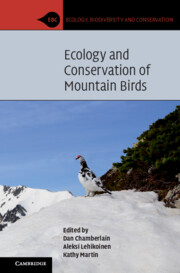Book contents
- Ecology and Conservation of Mountain Birds
- Ecology, Biodiversity and Conservation
- Ecology and Conservation of Mountain Birds
- Copyright page
- Contents
- Contributors
- Preface
- Acknowledgements
- 1 Mountain Birds and Their Habitats
- 2 Avian Adaptations to High Mountain Habitats
- 3 Global Bird Communities of Alpine and Nival Habitats
- 4 Birds of Treeline Ecotones
- 5 Population Trends of Mountain Birds in Europe and North America
- 6 Climate Change Impacts on Mountain Birds
- 7 Anthropogenic Activities and Mountain Birds
- 8 Modelling Large-Scale Patterns in Mountain Bird Diversity and Distributions
- 9 The Alpine Avifauna of Tropical Mountains
- 10 Priorities for Information, Research and Conservation of Birds in High Mountains
- Bird Species Index
- Subject Index
- Plate Section (PDF Only)
- References
4 - Birds of Treeline Ecotones
Published online by Cambridge University Press: 30 June 2023
- Ecology and Conservation of Mountain Birds
- Ecology, Biodiversity and Conservation
- Ecology and Conservation of Mountain Birds
- Copyright page
- Contents
- Contributors
- Preface
- Acknowledgements
- 1 Mountain Birds and Their Habitats
- 2 Avian Adaptations to High Mountain Habitats
- 3 Global Bird Communities of Alpine and Nival Habitats
- 4 Birds of Treeline Ecotones
- 5 Population Trends of Mountain Birds in Europe and North America
- 6 Climate Change Impacts on Mountain Birds
- 7 Anthropogenic Activities and Mountain Birds
- 8 Modelling Large-Scale Patterns in Mountain Bird Diversity and Distributions
- 9 The Alpine Avifauna of Tropical Mountains
- 10 Priorities for Information, Research and Conservation of Birds in High Mountains
- Bird Species Index
- Subject Index
- Plate Section (PDF Only)
- References
Summary
The mountain treeline forms the ecotone between the forest and the grass/shrub-heath dominated alpine zone and is often a zone of relatively high diversity. We first assess the universality of a peak in bird diversity at the treeline across studies and regions. Defining a ‘treeline’ bird is challenging, as this zone is often a mix of habitats, thus we determine whether any species can be classified as ‘treeline specialists’. We then compare bird communities of different mountain ranges and types of treeline: climate-limited, and those limited by disturbance, including of both natural (e.g. avalanches, grazing by wild herbivores) and anthropogenic (livestock grazing) origin. Furthermore, we assess the extent to which there are commonalities in broad traits (e.g. migratory strategy, foraging strategy, nesting substrate), primary origin (e.g. montane or alpine) and taxonomy (e.g. proportion of passerines vs non-passerines) across different treeline communities. We then review the determinants of reproductive success of treeline birds, the importance of vegetation structure, and the impact of grazing of both domestic and wild animals in maintaining the habitat mosaic. Finally, we consider how key threats to treeline bird communities might be confronted through conservation strategies.
Keywords
- Type
- Chapter
- Information
- Ecology and Conservation of Mountain Birds , pp. 137 - 175Publisher: Cambridge University PressPrint publication year: 2023
References
- 1
- Cited by



